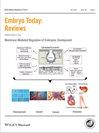Antionette L. Williams, Brenda L. Bohnsack
下载PDF
{"title":"眼发育中的神经嵴衍生物:辨别风暴眼","authors":"Antionette L. Williams, Brenda L. Bohnsack","doi":"10.1002/bdrc.21095","DOIUrl":null,"url":null,"abstract":"<p>Neural crest cells (NCCs) are vertebrate-specific transient, multipotent, migratory stem cells that play a crucial role in many aspects of embryonic development. These cells emerge from the dorsal neural tube and subsequently migrate to different regions of the body, contributing to the formation of diverse cell lineages and structures, including much of the peripheral nervous system, craniofacial skeleton, smooth muscle, skin pigmentation, and multiple ocular and periocular structures. Indeed, abnormalities in neural crest development cause craniofacial defects and ocular anomalies, such as Axenfeld-Rieger syndrome and primary congenital glaucoma. Thus, understanding the molecular regulation of neural crest development is important to enhance our knowledge of the basis for congenital eye diseases, reflecting the contributions of these progenitors to multiple cell lineages. Particularly, understanding the underpinnings of neural crest formation will help to discern the complexities of eye development, as these NCCs are involved in every aspect of this process. In this review, we summarize the role of ocular NCCs in eye development, particularly focusing on congenital eye diseases associated with anterior segment defects and the interplay between three prominent molecules, <i>PITX2</i>, <i>CYP1B1</i>, and retinoic acid, which act in concert to specify a population of neural crest-derived mesenchymal progenitors for migration and differentiation, to give rise to distinct anterior segment tissues. We also describe recent findings implicating this stem cell population in ocular coloboma formation, and introduce recent evidence suggesting the involvement of NCCs in optic fissure closure and vascular development. Birth Defects Research (Part C) 105:87–95, 2015. © 2015 Wiley Periodicals, Inc.</p>","PeriodicalId":55352,"journal":{"name":"Birth Defects Research Part C-Embryo Today-Reviews","volume":"105 2","pages":"87-95"},"PeriodicalIF":0.0000,"publicationDate":"2015-06-04","publicationTypes":"Journal Article","fieldsOfStudy":null,"isOpenAccess":false,"openAccessPdf":"https://sci-hub-pdf.com/10.1002/bdrc.21095","citationCount":"104","resultStr":"{\"title\":\"Neural crest derivatives in ocular development: Discerning the eye of the storm\",\"authors\":\"Antionette L. Williams, Brenda L. Bohnsack\",\"doi\":\"10.1002/bdrc.21095\",\"DOIUrl\":null,\"url\":null,\"abstract\":\"<p>Neural crest cells (NCCs) are vertebrate-specific transient, multipotent, migratory stem cells that play a crucial role in many aspects of embryonic development. These cells emerge from the dorsal neural tube and subsequently migrate to different regions of the body, contributing to the formation of diverse cell lineages and structures, including much of the peripheral nervous system, craniofacial skeleton, smooth muscle, skin pigmentation, and multiple ocular and periocular structures. Indeed, abnormalities in neural crest development cause craniofacial defects and ocular anomalies, such as Axenfeld-Rieger syndrome and primary congenital glaucoma. Thus, understanding the molecular regulation of neural crest development is important to enhance our knowledge of the basis for congenital eye diseases, reflecting the contributions of these progenitors to multiple cell lineages. Particularly, understanding the underpinnings of neural crest formation will help to discern the complexities of eye development, as these NCCs are involved in every aspect of this process. In this review, we summarize the role of ocular NCCs in eye development, particularly focusing on congenital eye diseases associated with anterior segment defects and the interplay between three prominent molecules, <i>PITX2</i>, <i>CYP1B1</i>, and retinoic acid, which act in concert to specify a population of neural crest-derived mesenchymal progenitors for migration and differentiation, to give rise to distinct anterior segment tissues. We also describe recent findings implicating this stem cell population in ocular coloboma formation, and introduce recent evidence suggesting the involvement of NCCs in optic fissure closure and vascular development. Birth Defects Research (Part C) 105:87–95, 2015. © 2015 Wiley Periodicals, Inc.</p>\",\"PeriodicalId\":55352,\"journal\":{\"name\":\"Birth Defects Research Part C-Embryo Today-Reviews\",\"volume\":\"105 2\",\"pages\":\"87-95\"},\"PeriodicalIF\":0.0000,\"publicationDate\":\"2015-06-04\",\"publicationTypes\":\"Journal Article\",\"fieldsOfStudy\":null,\"isOpenAccess\":false,\"openAccessPdf\":\"https://sci-hub-pdf.com/10.1002/bdrc.21095\",\"citationCount\":\"104\",\"resultStr\":null,\"platform\":\"Semanticscholar\",\"paperid\":null,\"PeriodicalName\":\"Birth Defects Research Part C-Embryo Today-Reviews\",\"FirstCategoryId\":\"1085\",\"ListUrlMain\":\"https://onlinelibrary.wiley.com/doi/10.1002/bdrc.21095\",\"RegionNum\":0,\"RegionCategory\":null,\"ArticlePicture\":[],\"TitleCN\":null,\"AbstractTextCN\":null,\"PMCID\":null,\"EPubDate\":\"\",\"PubModel\":\"\",\"JCR\":\"Q\",\"JCRName\":\"Medicine\",\"Score\":null,\"Total\":0}","platform":"Semanticscholar","paperid":null,"PeriodicalName":"Birth Defects Research Part C-Embryo Today-Reviews","FirstCategoryId":"1085","ListUrlMain":"https://onlinelibrary.wiley.com/doi/10.1002/bdrc.21095","RegionNum":0,"RegionCategory":null,"ArticlePicture":[],"TitleCN":null,"AbstractTextCN":null,"PMCID":null,"EPubDate":"","PubModel":"","JCR":"Q","JCRName":"Medicine","Score":null,"Total":0}
引用次数: 104
引用
批量引用




 求助内容:
求助内容: 应助结果提醒方式:
应助结果提醒方式:


